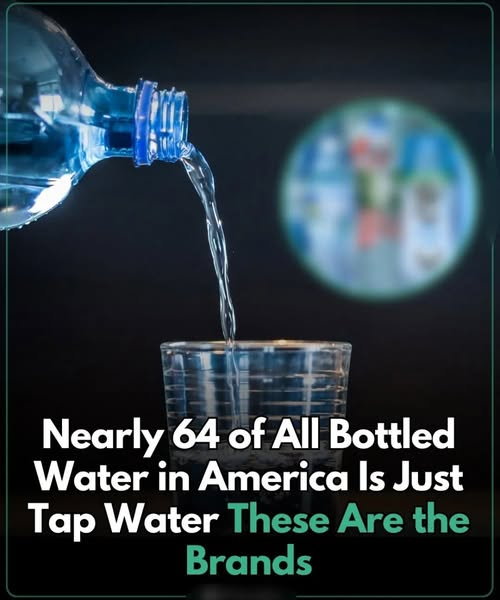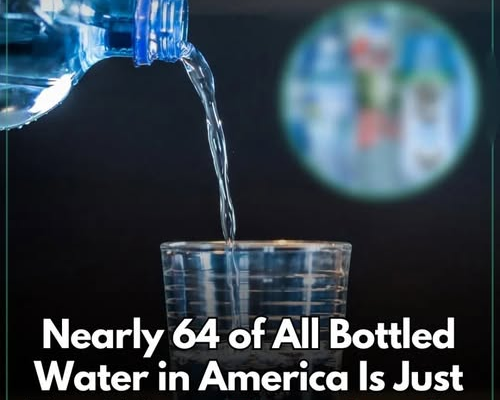Introduction: The Rise of Bottled Water Culture
Walk into any supermarket, convenience store, or even gas station in the United States, and one item is guaranteed to dominate the shelves—bottled water. Sleek plastic bottles with carefully designed labels promise “purity,” “freshness,” and “natural hydration.” Over the last few decades, bottled water has transformed from a niche product into a multi-billion-dollar industry. In fact, bottled water has now surpassed soda as America’s most consumed packaged beverage.
But behind the glossy marketing campaigns and images of pristine mountains, many Americans are beginning to ask an important question: Is bottled water really better than tap water?
A recent national study has added fuel to the debate, revealing that nearly 64% of bottled water sold in the United States originates from municipal sources—in simpler terms, the same tap water that flows into homes. While some companies run this water through additional purification processes, others make minimal changes before sealing it in a bottle and selling it at several hundred times the price of what it costs at the faucet.
This revelation challenges long-standing assumptions about bottled water and raises new discussions about value, safety, transparency, and environmental responsibility.
The Perception Versus the Reality
Most consumers who reach for bottled water believe they are choosing a product that is cleaner, safer, and healthier than tap water. Marketing strategies have reinforced this perception for decades. Images of snow-capped mountains, crystal-clear lakes, and untouched springs dominate advertisements.
Yet, the study paints a different picture. A significant portion of bottled water is simply treated tap water, repackaged and sold under the guise of purity. While some companies use advanced methods like reverse osmosis, distillation, or multi-step filtration, others make minor adjustments, such as adding minerals for taste or passing water through a basic filter.
The key takeaway is not that bottled water is unsafe, but that the perceived superiority over tap water may often be exaggerated.
Tap Water: More Regulated Than Many Realize
One surprising element of the bottled-versus-tap water debate is the difference in regulations. Municipal tap water is primarily overseen by the Environmental Protection Agency (EPA), which enforces strict safety standards across the nation. Water utilities are required to conduct frequent testing—sometimes multiple times a day—checking for contaminants such as bacteria, lead, arsenic, and other pollutants. Utilities must also provide annual water quality reports to the public, making results transparent.
Bottled water, on the other hand, falls under the jurisdiction of the Food and Drug Administration (FDA). While the FDA does regulate bottled water as a packaged product, the level of oversight is not always as consistent as municipal testing. Smaller bottling facilities, in particular, may not be required to test as often as public utilities. This means that in many cases, tap water is subject to stricter and more frequent monitoring than bottled water.
What Studies Have Found Inside Bottled Water
The study that revealed the “64% tap water” statistic is not the only one to cast doubt on bottled water’s reputation. Research conducted over the last decade has uncovered surprising findings in bottled water samples:
- Microplastics: Tiny particles of plastic, often invisible to the naked eye, have been detected in bottled water worldwide. These particles are believed to come from the bottle itself or the bottling process. While scientists are still studying their long-term health impacts, the discovery has raised concerns about potential risks.
- Chemical Contaminants: Some bottled water has been found to contain trace amounts of industrial chemicals, possibly leaching from packaging or introduced during bottling.
- Bacteria: In certain cases, bottled water samples tested positive for bacteria, highlighting that packaging does not necessarily guarantee sterility.
It’s important to note that these findings do not mean bottled water is inherently unsafe. In fact, most bottled water on the market meets general safety standards. However, the results challenge the assumption that bottled water is always purer or safer than what comes from the tap.
The Environmental Impact: A Hidden Cost
Beyond questions of purity, bottled water carries another cost—one that extends far beyond the checkout counter. The production of plastic bottles requires massive amounts of fossil fuels and water. It is estimated that producing a single plastic bottle of water may consume up to three times the amount of water it actually holds.
Then comes disposal. Each year, billions of plastic bottles are discarded, with only a fraction being recycled. Many end up in landfills, while others find their way into rivers and oceans, contributing to the global plastic pollution crisis. Marine life often mistakes small plastic particles for food, leading to ecological damage that ripples through entire ecosystems.
By contrast, choosing tap water, especially when combined with a reusable bottle or home filtration system, dramatically reduces environmental strain. It is both a cost-effective and eco-friendly alternative.
Why People Still Prefer Bottled Water
If tap water is often held to stricter standards and costs far less, why do so many Americans still choose bottled water? The answer lies in a combination of convenience, perception, and, in some regions, necessity.
- Convenience: Bottled water is easy to grab on the go, making it appealing for busy lifestyles.
- Taste and Smell: Some tap water has noticeable chlorine or mineral flavors, which bottled water brands often minimize through filtration or added minerals.
- Trust Issues: High-profile water crises, such as those in Flint, Michigan, have shaken public trust in municipal systems. In affected areas, bottled water can feel like the only safe option.
- Marketing Influence: For decades, bottled water companies have positioned their products as symbols of health and wellness, creating lasting brand loyalty.
The Economics of Bottled Water
One of the most striking contrasts between bottled and tap water is the cost. A gallon of tap water in the U.S. typically costs less than one cent. Bottled water, however, can range from $1 to $3 per bottle, making it hundreds—or even thousands—of times more expensive than what comes from the faucet.
This markup illustrates how much consumers are paying for packaging, branding, and convenience rather than the water itself. For families who regularly purchase bottled water, these costs can add up significantly over time.
Alternatives to Bottled Water
For those concerned about taste, odor, or safety of tap water, there are alternatives that combine health benefits with sustainability:
- Home Filtration Systems: Affordable filters, ranging from simple pitcher models to advanced under-sink systems, can remove impurities and improve taste.
- Reusable Bottles: Investing in a durable stainless steel or BPA-free plastic bottle not only saves money but also cuts down on plastic waste.
- Community Initiatives: Some cities now offer refill stations in public places, encouraging residents to refill bottles with filtered tap water on the go.
These options allow consumers to enjoy the convenience of bottled water without the environmental and financial downsides.
Looking Forward: Transparency and Trust
The bottled water industry is unlikely to disappear anytime soon. Its convenience and portability make it a staple for many households and travelers. However, growing consumer awareness may push companies to become more transparent about their sources and purification methods.
Some brands already voluntarily disclose detailed reports on where their water comes from and how it is treated. As demand for accountability grows, more companies may adopt this practice to build trust.
At the same time, strengthening municipal water infrastructure remains a critical goal. Ensuring that every community has access to safe, clean, and great-tasting tap water will reduce dependence on bottled alternatives.
Conclusion: Making Informed Choices
The study showing that nearly 64% of bottled water in America originates from municipal sources is a wake-up call. It doesn’t mean bottled water is inherently bad—it remains a safe and convenient option for many. But it does remind us that bottled water is not always what it seems.
In many cases, tap water not only meets but exceeds safety expectations while costing a fraction of the price. Combined with filtration systems and reusable bottles, tap water can offer health, savings, and sustainability all at once.
The real power lies with consumers. By staying informed, asking questions, and making conscious decisions, each of us can shape a healthier relationship with water—one that values safety, transparency, and environmental stewardship over clever marketing.
So, the next time you reach for a bottle of water, ask yourself: Am I buying purity, or just paying for packaging?




